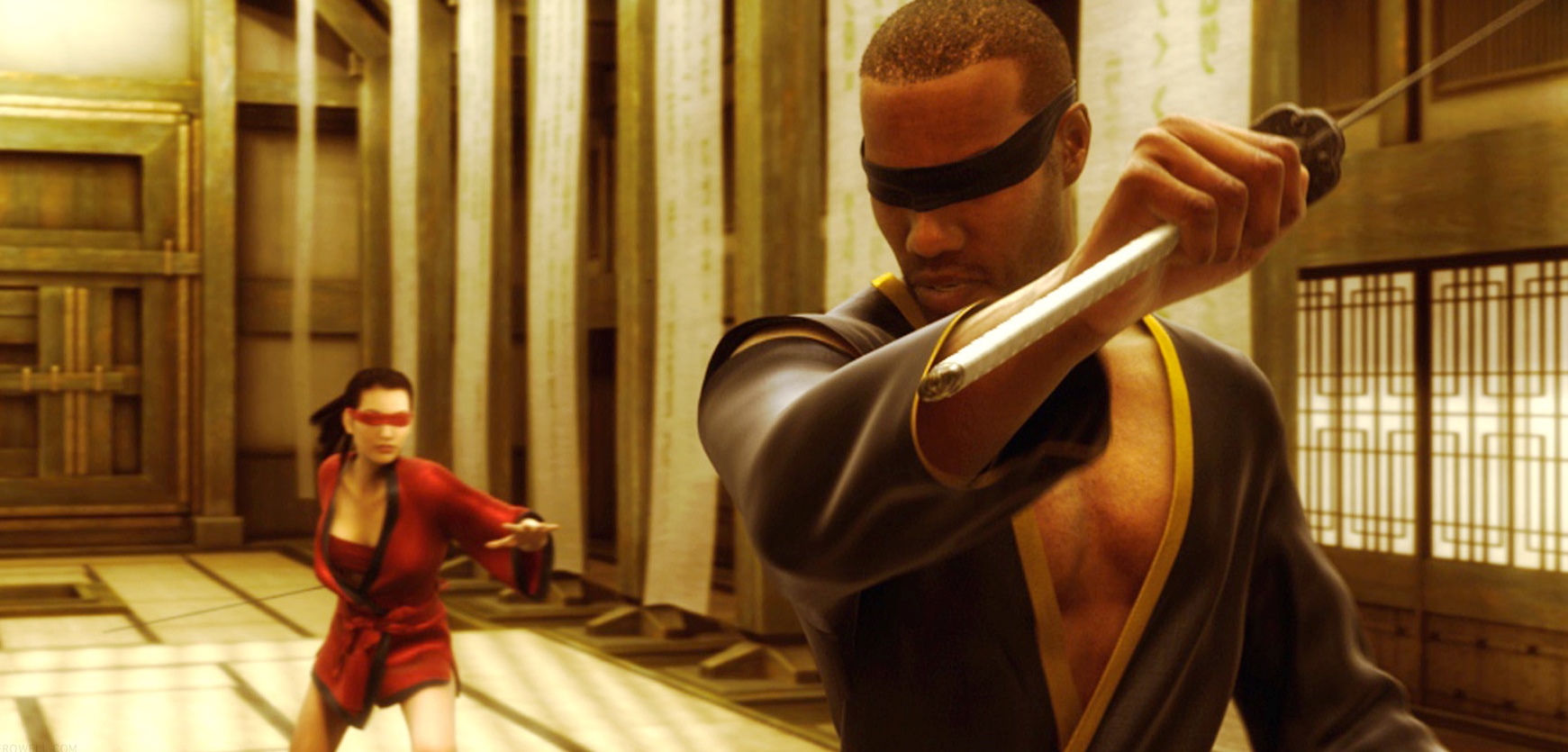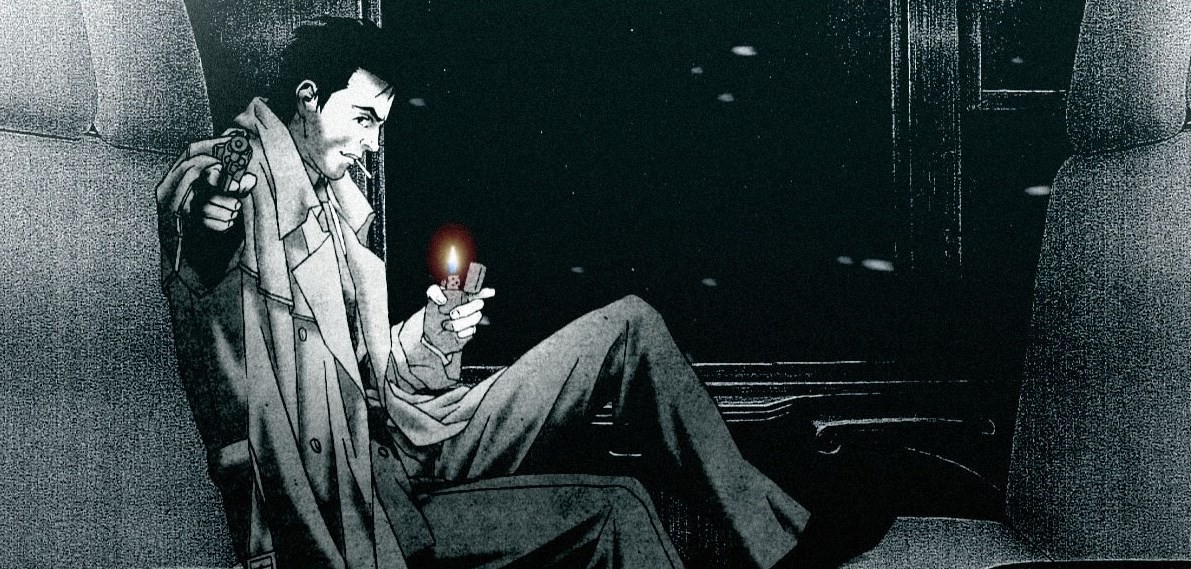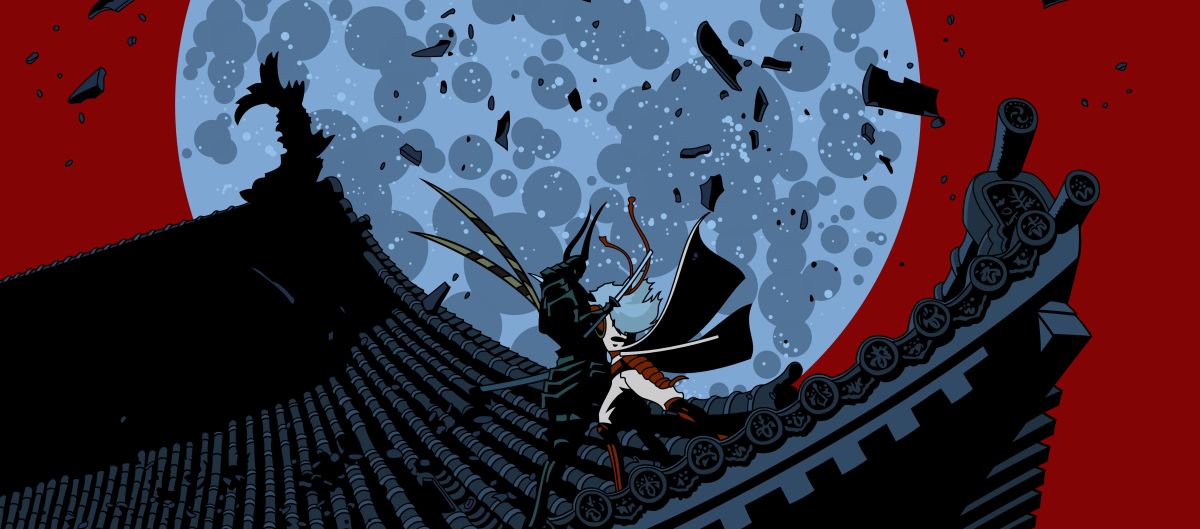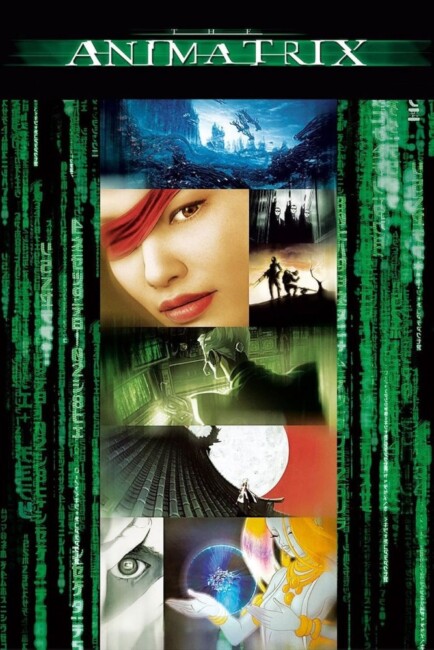USA. 2003.
Producers – Andy Wachowski & Larry Wachowski, Music – Don Davis.
Final Flight of the Osiris
Pamela Adlon (Jue), Kevin Michael Richardson (Thaddeus), Bette Ford (Old Woman)
The Second Renaissance Parts I & II
Julia Fletcher (The Instructor)
Kid’s Story
Clayton Watson (Michael Karl Popper/The Kid), John DeMita (Teacher)
Program
Hedy Burress (Cis), Phil Lamarr (Duo)
World Record
Victor Williams (Dan), Alex Fernandez (Tom), Allison Smith (Reporter), Tara Strong (Nurse), John Wesley (Dan’s Dad)
Beyond
Hedy Burress (Yoko)
A Detective Story
James Arnold Taylor (Ash), Carrie-Anne Moss (Trinity)
Matriculated
Melinda Clarke (Alexa)
Plot
Final Flight of the Osiris:- The scoutship Osiris detects a mass of Sentinels preparing to tunnel towards Zion. As the ship comes under attack by the Sentinels, Jue enters the Matrix in an attempt to get a warning to Zion. The Second Renaissance Part I:- Robots begin to rebel against humanity’s use of them as slave labour. They eventually set up their own country 01 but humanity resolutely refuses to recognise their status. The Second Renaissance Part II:- War ensues between the machines and humanity. Humanity responds by releasing bombs that block out the sunlight the machines need for power. However, as humanity starts losing the war, the machines turn to using human bodies as a power source. Kid’s Story:- Believing the dreams he has to be more real than the world he lives in, a teenager searches the net wondering if he is alone in this. He is contacted by Neo but this triggers the attention of the AIs who come to the teenager’s school to silence him. Program:- Cis and her lover Duo fight inside a samurai training simulation. He then announces that he wants to give up the revolution and return to life inside the Matrix and implores her to join him. World Record:- The athlete Dan is determined to compete in a track event and set a new world record, despite warnings from his coach of potential health hazards. However, Dan’s determination to push himself further on the field breaks through the illusion of the Matrix. Beyond:- Yoko goes searching for her missing cat and strays into an area where the Matrix has broken down and children have discovered that the normal rules of the world do not apply. A Detective Story:- The private detective Ash is hired by a mysterious client to find the hacker known as Trinity. Matriculated:- The warrior Alexa succeeds in capturing a Sentinel robot. She and several others then plug the Sentinel into the Matrix in an attempt to convince it to come over to their side.
The Animatrix is a compilation of animated shorts. The unique concept about it is that each of the nine shorts is set in the world of The Matrix (1999). The genesis of the Animatrix project came about when The achowskis (back when they were the Wachowski Brothers) travelled to Japan as part of the promotional tour for The Matrix and, being big fans of the genre, decided to visit various anime studios.
They then came up with the idea of The Animatrix as a theatrical and video compilation package to sit alongside their two live-actions sequels, The Matrix Reloaded (2003) and The Matrix Revolutions (2003). Indeed, The Wachowski Brothers even wrote several of the segments, with Final Flight of the Osiris being intended as a prequel to The Matrix Reloaded, explaining the events leading up to the machine invasion of Zion that is a crucial dramatic event that hangs over both films. Contrary to expectation, both Reloaded and Revolutions ended up universally disappointing audiences. In fact, some of the work here is so dazzling that The Animatrix ends up outstripping the quality of both the sequels that the collection was merely meant to accompany.
As with any anthology, the segments vary in effectiveness. The first segment, Final Flight of the Osiris, was the most high profile and even screened as an independent short that preceded that year’s theatrical release of Dreamcatcher (2003). Final Flight of the Osiris is made by Square, the Japanese videogame company behind the amazing computer-animated Final Fantasy: The Spirits Within (2001). (The segment’s director Andy Jones was animation supervisor on Final Fantasy). Final Flight of the Osiris has the same stunning almost photo-realistic textural depth that Final Fantasy did when it comes to the characters and the machine visuals. Osiris is also one of the weaker segments – it tends to be driven by action sequences rather than a story, while the ending comes as a downer. The opening scene does offer the amusing idea of a Matrix-styled Bullet Time sword training sequence enacted as a seduction.

The second and third segments come from Mahiro Maeda, previously an animator on various Hayao Miyazaki films and a creature designer on the modern Gamera films. These Second Renaissance segments attempt to tell an origin history of the Matrix universe. Although the story was drafted by the Wachowski Brothers, it tends to the simplistic at times with images – of robots being shot through the head, a female robot having her clothes and skin torn off – that seem designed with an anthropomorphic sentimentality that is intended to evoke human sympathy. One might also note that, despite the fact that the Matrix films regard the machines as evil, here they are treated sympathetically here and the episodes are definitely on their side and against humanity and its refusal to treat them as sentient entities. Mahiro Maeda opts for more traditional anime styles, employing a watercolour look. The animation is certainly very good with some strikingly violent depictions of the war between machine and humanity in the second part, including the unusual images of robotic horses and flying ships crossing the war-torn wasteland.
The fourth and eighth segments, Kid’s Story and A Detective Story, come from Shinichiro Watanabe, previously the creative force behind the cult anime tv series Cowboy Bebop (1998) and the film spinoff Cowboy Bebop: The Movie (2001). Kid’s Story distils the basics of the first few scenes of The Matrix and turns them into an often haunting meditation on teenage alienation. Shinichiro Watanabe draws the sequences with a sharp swirl of colours and creates at least one exhilarating scene with a skateboard chase through the school. The episode also features voice work from both Keanu Reeves and Carrie-Ann Moss.
Watanabe’s real triumph is A Detective Story, the most artistically dazzling of all the segments in The Animatrix. Here Watanabe pastiches film noir but also casts it with a futuristic look – the detective sitting in his shadow-laden office surfing the net, for instance. The artistic texture of this world is sunning, where Watanabe has drawn it almost all in black-and-white, using drawings of standard noir cityscapes but stylised in a way that makes them look like grainy multiple photocopies.

Yoshiaki Kawajiri, the director of the fifth episode, Program, is probably the most experienced director on the project. Kawajiri has made films such as Lensman (1984), Wicked City (1987), Demon City Shinjuku (1988), Ninja Scroll (1993), Vampire Hunter D: Bloodlust (2000) and Highlander: The Search for Vengeance (2007). The DVD’s making of documentaries gives much time over to Kawajiri. Program is made in a much more stylised form of anime, using bold lines, traditional anime figures with oversized eyes and drawn in extraordinarily bright colour contrasts. The action is vivid and the character contrasts – the boyfriend who wants to give up the revolution and return to the Matrix – is well conceived, as is the twist ending.
The sixth episode, World Record, is the directorial debut of Takeshi Koike, previously an animator on several of the abovementioned Yoshiaki Kawajiri’s films and subsequently the director of Redline (2009) and Lupin III: The Gravestone of Daisuke Jigen (2014). Conceptually, World Record is slight, but it is directed in an extraordinarily stylised way that seems like a two-colour graphic novel all drawn in jagged shapes and lines and where, in directing it, Takeshi Koike has hyper-emphasised almost every movement in slow motion.
The seventh episode, Beyond, comes from Koji Morimoto, who has worked as an animator for Hayao Miyazaki and Katsuhiro Otomo and on numerous tv series. He has directed various episodes of anime anthologies like Robot Carnival (1987) and Genius Party Beyond (2008), and is probably best remembered for the Magnetic Rose episode of the anime anthology Memories (1995). Kouji Morimoto’s contribution is the most conceptually striking of the segments. There is a wonderful simplicity to the concept – there are no ventures into virtual reality or combat with the machines in the piece, rather it is merely the story of children discovering an area where the illusion of the Matrix has broken down. There is something of the classic Stalker (1979) to the segment – of a zone where the normal rules of the world no longer apply. There are beautifully poetic images of a thrown can suddenly freezing in mid-air, a smashed bottle reconstituting, a pigeon stilled in mid-air, boys jumping and being able to hover millimetres from the ground, land on one hand or conduct graceful slow-motion backflips. here is something incredibly sad to the final images of the children returning after the repair crews enter the area and trying but failing to conduct more flips.

The final episode, Matriculated, comes from Peter Chung, the only other non-Japanese director on board (Chung is South Korean but resides in the US). Peter Chung is most famous as creator of the cult tv series Aeon Flux (1991-2, 1995) and subsequently went on to direct The Chronicles of Riddick: Dark Fury (2004). Aeon Flux was filled with Peter Chung’s penchant for eccentric images and Matriculated allows him to expand on these using CGI. Chung uses the concept as an opportunity to leap off into an extraordinarily colourful piece of abstract CGI animation – people converted into god-like avatars lit up in gold light, a scene where the robot character is stripped of its metal skin and sees it turned into a bouncing metal ball, and a remarkable series of evolutions and changes and amazingly surreal backgrounds, all directed in a maximum of brilliant colours. The earlier part of the segment is taken up by a striking battle between non-humanoid robots. There is a hauntingly lovely ending where everybody is killed and the converted machine takes the human woman back into the Matrix trying to reconnect with her, only for them both to expire.
The idea of conducting an anime version of a popular film or game franchise has proven surprisingly popular since with other works like Final Fantasy VII: Advent Children (2005), Highlander: The Search for Vengeance (2007), Batman: Gotham Knight (2008), Resident Evil: Degeneration (2008), Halo Legends (2010), Mass Effect: Paragon Lost (2012), Resident Evil: Damnation (2012), Starship Troopers: Invasion (2012), Iron Man: Rise of Technovore (2013), Resident Evil: Vendetta (2017), Starship Troopers: Traitor of Mars (2017), Batman Ninja (2018), Altered Carbon: Resleeved (2020), Blade Runner: Black Lotus (2021-2), Tomb Raider: The Legend of Lara Croft (2024- ), The Lord of the Rings: The War of the Rohirrim (2024) and Terminator Zero (2024).
Trailer here


